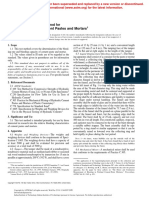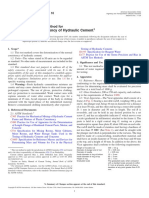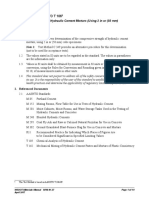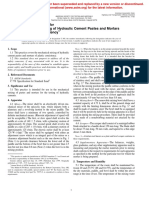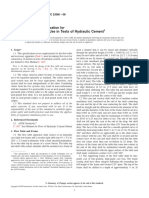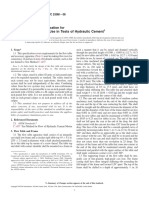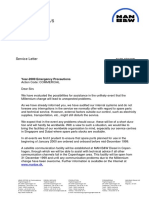Normal Consistency of Hydraulic Cement: Standard Method of Test For
Normal Consistency of Hydraulic Cement: Standard Method of Test For
Uploaded by
Evert RiveraCopyright:
Available Formats
Normal Consistency of Hydraulic Cement: Standard Method of Test For
Normal Consistency of Hydraulic Cement: Standard Method of Test For
Uploaded by
Evert RiveraOriginal Description:
Original Title
Copyright
Available Formats
Share this document
Did you find this document useful?
Is this content inappropriate?
Copyright:
Available Formats
Normal Consistency of Hydraulic Cement: Standard Method of Test For
Normal Consistency of Hydraulic Cement: Standard Method of Test For
Uploaded by
Evert RiveraCopyright:
Available Formats
T 129 METHODS OF SAMPLING AND TESTING
Standard Method of Test for
Normal Consistency of Hydraulic Cement
AASHTO DESIGNATION: T 129-88
(ASTM DESIGNATION: C 187-86e1)
1. SCOPE Specification ASTM C 1005. The 6. PROCEDURE
weighing device shall be evaluated for
precision and accuracy at a total load of
1.1 This method covers determination of 1,000 g. 6.1 Preparation of Cement PasteMix 650
the normal consistency of hydraulic g of cement with a measured quantity of
cement. 4.2 Glass Graduates-200 or 250 mL clean water following the procedure
capacity and conforming to the prescribed in Section 6 of T 162.
1.2 This standard may involve hazardous requirements of M 210.
materials, operations, and equipment. 6.2 Molding Test SpecimenQuickly form
This standard does not purport to address 4.3 Vicat Apparatus-The Vicat apparatus the cement paste, prepared as described
all of the safety problems associated with shall consist of a frame A (Figure 1) in Section 6.1 into the approximate shape
its use. It is the responsibility of whoever bearing a movable rod B, weighing 300 of a ball with gloved hands. Then toss six
uses this standard to consult and establish g, one end C, the plunger end, being 10 times through a free path of about 6 in.
appropriate safety and health practices mm in diameter for a distance of at least (150 mm) from one hand to another so as
and determine the applicability of 50 mm, and the other end having a to produce a nearly spherical mass that
regulatory limitations prior to use. removable needle D, 1 mm in diameter may be easily inserted into the Vicat ring
and 50 mm in length. The rod B is with a minimum amount of additional
reversible, and can be held in any desired manipulation. Press the ball, resting in
2. REFERENCED DOCUMENTS position by a set screw E, and has an the palm of one hand, into the larger end
adjustable indicator F which moves over of the conical ring G, Figure 1, held in
a scale (graduated in millimetres) the other hand, completely filling the ring
2.1 AASHTO Standards:
attached to the frame A. The paste is held with paste. Remove the excess at the
M 210 Apparatus for Use in in a rigid conical ring G, resting on a larger end by a single movement of the
Measurement of Length plane non-absorptive square base plate H palm of the hand. Place the ring on its
Change of Hardened Cement about 100 mm' on each side. The rod B larger end on the base plate H, and slice
Paste, Mortar, and Concrete shall be made of stainless steel having a off the excess paste at the smaller end at
R 11 Indicating Which Places of hardness of not less than 35 HRC (Note), the top of the ring by a single oblique
Figures Are to be Considered and shall be straight with the plunger end stroke of a sharpedged trowel held at a
Significant in Specified which is perpendicular to the rod axis. slight angle with the top of the ring, and
Limiting Values The ring shall be made of a smooth the top, if necessary, with a few
T 162 Mechanical Mixing of noncorroding, nonabsorbent material, and light touches of the pointed end of the
Hydraulic Cement Pastes and shall have an inside diameter of 70 mm at trowel. During these operations of cutting
Mortars of Plastic the base and 60 mm at the top, and a and smoothing, take care not to compress
Consistency height of 40 mm. In addition to the the paste.
above, the Vicat apparatus shall conform
2.2 ASTM Standards: to the requirements as indicated in the 6.3 Consistency Determination-Center
C 1005 Specifications for Weights table entitled "Vicat Apparatus." the paste confined in the ring, resting on
and Weighing Devices for the plate, under the rod B, Figure 1, the
Use in the Physical Testing of NOTE-The requirement that the rod be made plunger end C of which shall be brought
Hydraulic Cements of stainless steel shall apply only to new Vicat in contact with the surface of the paste,
apparatus or replacement rods and not to and tighten the setscrew E. Then set the
E 177 Use of the Terms Precision equipment in use which meets the other movable indicator F to the upper zero
and Accuracy as Applied to requirements of T 129. mark of the scale, or take an initial
Measurements of a Property reading and release the rod immediately.
of a Material This must not exceed 30 seconds after
5. TEMPERATURE AND
HUMIDITY completion of mixing. The apparatus
3. SIGNIFICANCE AND USE shall be free of all vibrations during the
test. The paste shall be of normal
5.1 The temperature of the air in the consistency when the rod settles to a
3.1 This method is intended to be used to vicinity of the mixing slab, the dry point 10 ± 1 mm below the original
determine the amount of water required cement, molds, and base plates shall be surface in 30 seconds after being
to prepare hydraulic cement pastes for maintained between 20 and 27.5°C (68 released. Make trial pastes with varying
testing. and 81.5°F). The temperature of the percentages of water until the normal
mixing water shall not vary from 23°C consistency is obtained. Make each trial
(73.4°F) by more than ± 1.7°C (3°F). with fresh cement.
4. APPARATUS
5.2 The relative humidity of the
laboratory shall be not less than 50
4.1 Weights and Weighing Devices-The percent.
weights and weighing devices shall
conform to the requirements of
193
T 129 METHODS OF SAMPLING AND TESTING
7. CALCULATION 8. PRECISION operator in a laboratory should agree
within 0.7 percentage point, and test
results between two laboratories should
7.1 Calculate the amount of water 8.1 The single operator-instrument agree within 1.0 percentage point 95
required for normal consistency to the precision has been found to be 0.25(1S). percent of the time.
nearest 0.1 percent and report it to the and the multilaboratory precision has
nearest 0.5 percent of the weight of the been found to be 0.35(1S) as defined in
dry cement. ASTM E 177; therefore, the results of
two properly conducted tests by the same
Vicat Apparatus
Weight of movable rod 300 ± 0.5 g (0.661 lb 8 grains)
Diameter of plunger end of rod 10 t 0.05 mm (0.394 ± 0.002 in.)
Diameter of needle 1 ± 0.05 mm (0.039 ± 0.002 in.)
Inside diameter of ring at bottom 70 ± 3 mm (2.75 =0.12in.)
Inside diameter of ring at top 60 ± 3 mm (2.36 =0.12in.)
Height of ring 40 ± 1 mm (1.57 = 0.04 in.)
Graduated scale The graduated scale, when compared with a standard scale accurate to within 0.1 mm at all points, shall not
show a deviation at any point greater than 0.25 mm.
194
You might also like
- Stadium AtlasDocument17 pagesStadium AtlasNeeraj Desai83% (6)
- TM1 1520 237 23 5Document855 pagesTM1 1520 237 23 5joel alvarado80% (5)
- The Semiconductor IndustryDocument30 pagesThe Semiconductor IndustryTi ViNo ratings yet
- Length Change of Hardened Hydraulic Cement Mortar and ConcreteDocument5 pagesLength Change of Hardened Hydraulic Cement Mortar and ConcreteEvert RiveraNo ratings yet
- Sampling Bituminous Materials: Standard Method of Test ForDocument3 pagesSampling Bituminous Materials: Standard Method of Test ForEvert RiveraNo ratings yet
- Astm c243 Withdrawn.31346Document4 pagesAstm c243 Withdrawn.31346SilvioCarrilloNo ratings yet
- Final Wa 310.1 - 13 01 2012Document5 pagesFinal Wa 310.1 - 13 01 2012Pavitra SinghNo ratings yet
- Engineering Drawings Lecture Assembly DrawingsDocument10 pagesEngineering Drawings Lecture Assembly DrawingsAvemasterNo ratings yet
- Normal Consistency of Hydraulic Cement: Standard Test Method ForDocument2 pagesNormal Consistency of Hydraulic Cement: Standard Test Method ForAnggit TetukoNo ratings yet
- Time Setting of Hydraulic Cement by Vicat Needle: Standard Method of Test ForDocument2 pagesTime Setting of Hydraulic Cement by Vicat Needle: Standard Method of Test ForEvert RiveraNo ratings yet
- Lab ManualDocument19 pagesLab ManualAmar WadoodNo ratings yet
- C187 - Normal Consistency of Hydraulic CementDocument3 pagesC187 - Normal Consistency of Hydraulic CementWisam WisamNo ratings yet
- Time of Setting of Hydraulic Cement by Vicat Needle: Standard Test Method ForDocument3 pagesTime of Setting of Hydraulic Cement by Vicat Needle: Standard Test Method ForNazmus SakibNo ratings yet
- Astm C 191Document3 pagesAstm C 191Alexis DominguezNo ratings yet
- C 191 Â " 01 QZE5MS0WMQ - PDFDocument3 pagesC 191 Â " 01 QZE5MS0WMQ - PDFDänïlö MönröyNo ratings yet
- Amount of Water Required For Normal Consistency of Hydraulic Cement PasteDocument3 pagesAmount of Water Required For Normal Consistency of Hydraulic Cement PasteThurain Aung KyawNo ratings yet
- Normal Consistency of Hydraulic CementDocument5 pagesNormal Consistency of Hydraulic CementCj NievaNo ratings yet
- Exp 1Document5 pagesExp 1sju65No ratings yet
- Astm C187Document3 pagesAstm C187MonserratNo ratings yet
- Amount of Water Required For Normal Consistency of Hydraulic Cement PasteDocument3 pagesAmount of Water Required For Normal Consistency of Hydraulic Cement PasteHammad SalahuddinNo ratings yet
- PRC ManualDocument31 pagesPRC ManualTaha ArshadNo ratings yet
- خرسانة عمليDocument42 pagesخرسانة عمليAL SniperNo ratings yet
- Time of Setting of Hydraulic Cement Mortar by Modified Vicat NeedleDocument3 pagesTime of Setting of Hydraulic Cement Mortar by Modified Vicat NeedleB Kumar BNo ratings yet
- Flow of Hydraulic Cement Mortar: Standard Test Method ForDocument2 pagesFlow of Hydraulic Cement Mortar: Standard Test Method ForJaime Arnaldo Montelongo GarciaNo ratings yet
- ASTM C 187 - Water RequirementDocument4 pagesASTM C 187 - Water RequirementthainafariaolivNo ratings yet
- Astm C187Document3 pagesAstm C187Fred AguayoNo ratings yet
- Flow of Hydraulic Cement Mortar: Standard Test Method ForDocument2 pagesFlow of Hydraulic Cement Mortar: Standard Test Method FordalalNo ratings yet
- EngineeringMaterials Lab ManualDocument65 pagesEngineeringMaterials Lab ManualJeny Sazeda100% (1)
- WSDOT FOP For AASHTO T 106Document14 pagesWSDOT FOP For AASHTO T 106malaya tripathyNo ratings yet
- Time of Setting of Hydraulic Cement by Gillmore Needles: Standard Method of Test ForDocument2 pagesTime of Setting of Hydraulic Cement by Gillmore Needles: Standard Method of Test ForEvert RiveraNo ratings yet
- ASTM-C187-16Document2 pagesASTM-C187-16shishirkhan621615No ratings yet
- Autoclave Expansion of Portland Cement: Standard Method of Test ForDocument2 pagesAutoclave Expansion of Portland Cement: Standard Method of Test ForEvert RiveraNo ratings yet
- T119Document2 pagesT119Katerin HernandezNo ratings yet
- Flow of Hydraulic Cement Mortar: Standard Test Method ForDocument2 pagesFlow of Hydraulic Cement Mortar: Standard Test Method ForCarineMolz100% (1)
- Time of Setting of Setting Using Vicat ApparatusDocument11 pagesTime of Setting of Setting Using Vicat ApparatusCj NievaNo ratings yet
- LAB Manual PRCIIDocument61 pagesLAB Manual PRCIIUbaid RajputNo ratings yet
- Fineness of Portland Cement by Air Permeability Apparatus: NOTE 2-Filter Paper Disks That Are Too SmallDocument5 pagesFineness of Portland Cement by Air Permeability Apparatus: NOTE 2-Filter Paper Disks That Are Too SmallEvert RiveraNo ratings yet
- Setting Time - Vicat Needle ASTM C 191Document10 pagesSetting Time - Vicat Needle ASTM C 191alex_g00dy100% (1)
- Astm 187Document2 pagesAstm 187LC LeeNo ratings yet
- Methods of Physical Tests For Hydraulic Cement: Indian StandardDocument3 pagesMethods of Physical Tests For Hydraulic Cement: Indian StandardApurv PatelNo ratings yet
- Astm C1437 - 20Document2 pagesAstm C1437 - 20Maricel NgaganNo ratings yet
- Flow Table For Use in Tests of Hydraulic CementDocument6 pagesFlow Table For Use in Tests of Hydraulic CementGhost_suolNo ratings yet
- CTM 202 Jun2008 A11yDocument15 pagesCTM 202 Jun2008 A11yebadatmallick6No ratings yet
- C 305 - 99 - Qzmwns05oqDocument3 pagesC 305 - 99 - Qzmwns05oqarhianmNo ratings yet
- Slump of Hydraulic Cement Concrete: NOTE 2-Concretes Having Slumps Less ThanDocument2 pagesSlump of Hydraulic Cement Concrete: NOTE 2-Concretes Having Slumps Less ThanEvert RiveraNo ratings yet
- Tape Calibration Procedure SOP11 - 20141022Document15 pagesTape Calibration Procedure SOP11 - 20141022Bvel2019No ratings yet
- Specific Bendability of Pipeline Coatings: Standard Test Method ForDocument3 pagesSpecific Bendability of Pipeline Coatings: Standard Test Method Forvuqar0979No ratings yet
- Technical SpecificationsDocument50 pagesTechnical SpecificationsrotisnoNo ratings yet
- Fineness of Hydraulic Cement by The #100 (150 - M) and 200 (75 - M) SievesDocument2 pagesFineness of Hydraulic Cement by The #100 (150 - M) and 200 (75 - M) SievesEvert RiveraNo ratings yet
- Time of Setting of Hydraulic Cement Mortar by Modified Vicat NeedleDocument3 pagesTime of Setting of Hydraulic Cement Mortar by Modified Vicat Needlehanat asharNo ratings yet
- Cement C 187Document55 pagesCement C 187Al ImranNo ratings yet
- Is17127 2019Document14 pagesIs17127 2019GaneshBuilder .BatalalabNo ratings yet
- Astm C 305Document3 pagesAstm C 305Kolawolejt100% (1)
- ASTM C230C230M-08 Standard Specification For Flow Table For Use in Tests of Hydraulic CementDocument2 pagesASTM C230C230M-08 Standard Specification For Flow Table For Use in Tests of Hydraulic CementGanesh PersaudNo ratings yet
- Amount of Water Required For Normal Consistency of Hydraulic Cement PasteDocument3 pagesAmount of Water Required For Normal Consistency of Hydraulic Cement PasteMaria Del Carmen Liberato MarquezNo ratings yet
- Saso 142Document40 pagesSaso 142Ayman EwaisNo ratings yet
- Astm E-100 PDFDocument10 pagesAstm E-100 PDFannaNo ratings yet
- Aashto T312-08Document7 pagesAashto T312-08Wassim FEKI100% (1)
- (Issued 1 June 1971) CRD-C 516-71 C 516Document4 pages(Issued 1 June 1971) CRD-C 516-71 C 516Misr RaymondNo ratings yet
- Flow Table For Use in Tests of Hydraulic CementDocument6 pagesFlow Table For Use in Tests of Hydraulic CementJose Francisco Villarreal CanalesNo ratings yet
- Flexural Strength of Hydraulic-Cement Mortars: Standard Test Method ForDocument6 pagesFlexural Strength of Hydraulic-Cement Mortars: Standard Test Method ForVikas SharmaNo ratings yet
- Astm C191 08Document6 pagesAstm C191 08Ross Emerson RealinoNo ratings yet
- CRD c260 PDFDocument8 pagesCRD c260 PDFJersey Mae PerlasNo ratings yet
- Comparing Concrete On The Basis of The Bond Developed With Reinforcing SteelDocument4 pagesComparing Concrete On The Basis of The Bond Developed With Reinforcing SteelEvert RiveraNo ratings yet
- Making and Curing Concrete Test Specimens in The Laboratory: Standard Method of Test ForDocument6 pagesMaking and Curing Concrete Test Specimens in The Laboratory: Standard Method of Test ForEvert RiveraNo ratings yet
- Tensile Strength of Hydraulic Cement Mortars: Standard Method of Test ForDocument4 pagesTensile Strength of Hydraulic Cement Mortars: Standard Method of Test ForEvert RiveraNo ratings yet
- Sampling and Amount of Testing of Hydraulic CementDocument5 pagesSampling and Amount of Testing of Hydraulic CementEvert RiveraNo ratings yet
- Fineness of Hydraulic Cement by The #100 (150 - M) and 200 (75 - M) SievesDocument2 pagesFineness of Hydraulic Cement by The #100 (150 - M) and 200 (75 - M) SievesEvert RiveraNo ratings yet
- Calculation of Winding Temperatures in DistributionDocument6 pagesCalculation of Winding Temperatures in DistributionKhashane Willy Mohale100% (1)
- Nabl 400Document991 pagesNabl 400Sharon Susmitha100% (1)
- M CompressedDocument198 pagesM CompressedAlex ParedesNo ratings yet
- CVDocument6 pagesCVJohn Vivian PrashantNo ratings yet
- Est - IecepDocument2 pagesEst - IecepJeffrey BernardoNo ratings yet
- OFFERDocument1 pageOFFERHEMANT RAMJINo ratings yet
- Equipment Design - Precipitation Tank 2Document12 pagesEquipment Design - Precipitation Tank 2Aldous Tabuzo100% (1)
- Manesty Coating Presentation - 2009Document16 pagesManesty Coating Presentation - 2009niknenadNo ratings yet
- GhostDocument9 pagesGhostArun KumarNo ratings yet
- Terex Finlay 984 Horizontal Screen PDFDocument4 pagesTerex Finlay 984 Horizontal Screen PDFeaglego000% (1)
- MMEL PL-34 Rev 5 DraftDocument4 pagesMMEL PL-34 Rev 5 DraftJoão Paulo LapaNo ratings yet
- DPO Brochure Philippines PDFDocument2 pagesDPO Brochure Philippines PDFItatchi RegenciaNo ratings yet
- Textile in DepthDocument59 pagesTextile in DepthBoopathi Sadasivam50% (2)
- Method Statement For Concrete WorksDocument12 pagesMethod Statement For Concrete WorksNaeemNo ratings yet
- Programming Project, C++ ProgrammingDocument11 pagesProgramming Project, C++ Programmingmechanical tricksNo ratings yet
- Insulation MBMA-NAIMA Acousticical Performance Guide Noise SoundDocument26 pagesInsulation MBMA-NAIMA Acousticical Performance Guide Noise SoundDianna LambertNo ratings yet
- PowerPoint Presentation of Convex MirrorDocument25 pagesPowerPoint Presentation of Convex MirrorPanuncialman, Johanna Mary B.No ratings yet
- 8L22HLX Parts CatalogDocument95 pages8L22HLX Parts CatalogRafael HerreraNo ratings yet
- Trombe Wall and Soalrium: Submitted By: Ibli Nehal Nidhi Ubaid ShrutiDocument12 pagesTrombe Wall and Soalrium: Submitted By: Ibli Nehal Nidhi Ubaid ShrutiShruti SinghNo ratings yet
- Safety Data Sheet: Section 1. IdentificationDocument13 pagesSafety Data Sheet: Section 1. Identificationrahulsaini855No ratings yet
- Test Specimen Mold SystemsDocument62 pagesTest Specimen Mold SystemsLập Nguyễn TấnNo ratings yet
- SL1999-372 Year-2000 Emergency PrecautionsDocument2 pagesSL1999-372 Year-2000 Emergency Precautionssail2karthikNo ratings yet
- ListDocument1 pageListAbyan FarrasNo ratings yet
- Packets 2 SolidsDocument19 pagesPackets 2 SolidsNeldor A. MosquiteNo ratings yet
- EGK Butterfly Valve VE200+VE201Document2 pagesEGK Butterfly Valve VE200+VE201Sai PrasathNo ratings yet
- Free Cyanide Analysis by Silver Nitrate Titration With SDocument3 pagesFree Cyanide Analysis by Silver Nitrate Titration With Sboanerges wino patty0% (1)





